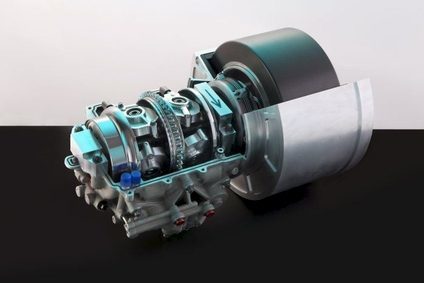
Volvo Car Group says it has been conducting extensive tests on flywheel-based KERS ( (Kinetic Energy Recovery System) technology that can yield fuel consumption savings of up to 25%.
The company is working with UK-based technology partner Flybrid.

Discover B2B Marketing That Performs
Combine business intelligence and editorial excellence to reach engaged professionals across 36 leading media platforms.
The four-year partnership, using real-world driving data from tests on public roads and test tracks in both Sweden and the UK, has shown that the flywheel-based hybrid technology can deliver an 80hp performance boost, together with fuel savings of up to 25%.
The system is the first full-scale trial of a rear-axle mounted flywheel system in a front-wheel-drive passenger car and is the result of a partnership between Flybrid, Volvo and the Swedish government. Flybrid Automotive founder Jon Hilton, now Commercial Director of Torotrak plc following Flybrid’s acquisition by the Group in 2014, is pleased to support Volvo’s UK testing: “This car is a great demonstration of how close to market this technology could be, and how class-leading fuel efficiency can be combined with real performance and driver enjoyment.”
The Flybrid KERS is fitted to the rear axle of an S60 powered by a 254hp five-cylinder T5 petrol engine. Under braking, kinetic energy which would otherwise be lost as heat is transferred from the wheels to the KERS, and is used to spin a 6kg carbon fibre flywheel at up to 60,000 revs per minute. When the car starts moving off again, energy stored in the spinning flywheel is transferred back to the rear wheels via a specially designed transmission, and can either boost power or reduce load on the engine.
The combustion engine that drives the front wheels is switched off as soon as braking begins. The energy in the flywheel can then be used to accelerate the vehicle when it is time to move off again or to power the vehicle once it reaches cruising speed.
“The flywheel’s stored energy is sufficient to power the car for short periods. This has a major impact on fuel consumption. Our calculations indicate that it will be possible to turn off the combustion engine about half the time when driving according to the official New European Driving Cycle,” says Derek Crabb, Vice President Powertrain Engineering at Volvo Car Group.
“We are the first manufacturer that has applied flywheel technology to the rear axle of a car fitted with a combustion engine driving the front wheels. The next step after completing these successful tests is to evaluate how the technology can be implemented in our upcoming car models,” adds Crabb.
In an interview last year, Flybrid’s Jon Hilton told just-auto that Volvo is aiming for the system to be in a production vehicle by 2017.
See also: INTERVIEW: Jon Hilton, MD Flybrid Systems






